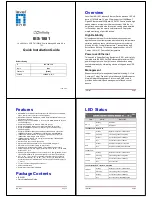
+7(495) 797-3311 www.qtech.ru
Москва, Новозаводская ул., 18, стр. 1
171
entries and enhances the efficiency and expansibility of routing and data packet processing.
The header design of IPv6 is more efficient compared with IPv4. It has less data fields and
takes out header checksum, thus expedites the processing speed of basic IPv6 header. In
IPv6 header, fragment field can be shown as an optional extended field, so that data packets
fragmentation process won’t be done in router forwarding process, and Path MTU Discovery
Mechanism collaborates with data packet source which enhances the processing efficiency of
router.
Address automatic configuration and plug-and-play is supported. Large amounts of hosts can
find network routers easily by address automatic configuration function of IPv6 while obtaining
a globally unique IPv6 address automatically as well which makes the devices using IPv6
Internet plug-and-play. Automatic address configuration function also makes the readdressing
of existing network easier and more convenient, and it is more convenient for network
operators to manage the transformation from one provider to another.
Support IPSec. IPSec is optional in IPv4, but required in IPv6 Protocol. IPv6 provides security
extended header, which provides end-to-end security services such as access control,
confidentiality and data integrity, consequently making the implement of encryption, validation
and Virtual Private Network easier.
Enhance the support for Mobile IP and mobile calculating devices. The Mobile IP Protocol
defined in IETF standard makes mobile devices movable without cutting the existing
connection, which is a network function getting more and more important. Unlike IPv4, the
mobility of IPv6 is from embedded automatic configuration to get transmission address (Care-
Of-
Address); therefore it doesn’t need Foreign Agent. Furthermore, this kind of binding process
enables Correspondent Node communicate with Mobile Node directly, thereby avoids the extra
system cost caused by triangle routing choice required in IPv4.
Avoid the use of Network Address Translation. The purpose of the introduction of NAT
mechanism is to share and reuse same address space among different network segments.
This mechanism mitigates the problem of the shortage of IPv4 address temporally; meanwhile
it adds the burden of address translation process for network device and application. Since the
address space of IPv6 has increased greatly, address translation becomes unnecessary, thus
the problems and system cost caused by NAT deployment are solved naturally.
Support extensively deployed Routing Protocol. IPv6 has kept and extended the supports for
existing Internal Gateway Protocols (IGP for short), and Exterior Gateway Protocols (EGP for
short). For example, IPv6 Routing Protocol such as RIPng, OSPFv3, IS-ISv6 and MBGP4+,
etc.
Multicast addresses increased and the support for multicast has enhanced. By dealing with
IPv4 broadcast functions such as Router Discovery and Router Query, IPv6 multicast has
completely replaced IPv4 broadcast in the sense of function. Multicast not only saves network
bandwidth, but enhances network efficiency as well.
Содержание QSW-2800 series
Страница 189: ...7 495 797 3311 www qtech ru 18 1 175...
Страница 414: ...7 495 797 3311 www qtech ru 18 1 400...
















































